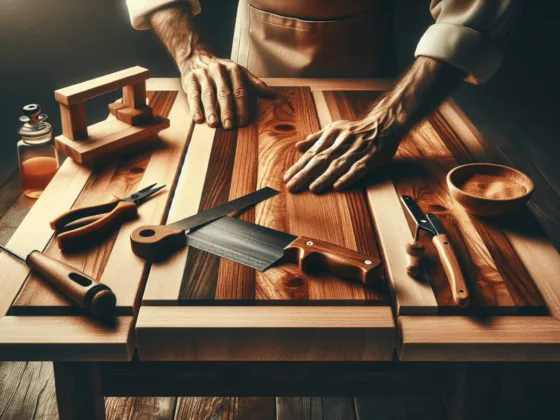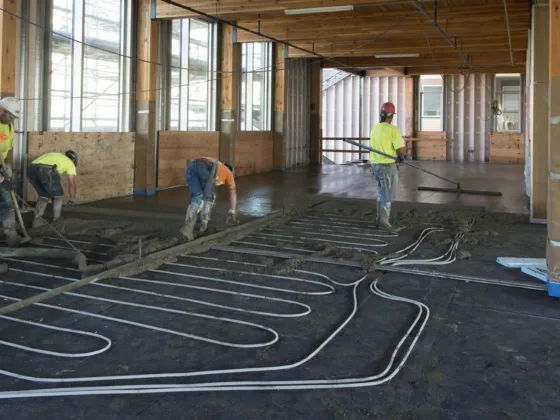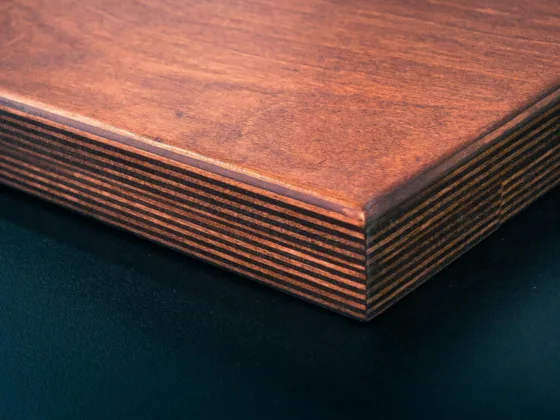Table of Contents Show
Did you know that more than 50% of households in the U.S. own physical books? Home libraries are gaining popularity as people seek comfort and sanctuary in their own spaces. Creating a home library offers numerous benefits, including a personal retreat, easy access to knowledge, and an opportunity to showcase your personality.
This guide lays out clear steps to help you design and set up a beautiful home library that reflects your style while meeting your needs.
Choosing the Perfect Space
Choosing the perfect space for your library is essential to creating an inviting and functional reading area. Start by carefully assessing your home to identify the best potential locations for this special nook.
Assessing Your Home: Identifying Potential Library Locations
When it comes to creating your personal library at home, choosing the right location is vital. The spot you select can influence your reading experience significantly.
Consider Natural Light
First and foremost, consider the amount of natural light in potential spaces. Bright sunlight makes it easier to read for long periods and can create a warm, inviting atmosphere. Areas with ample windows are ideal, as they help reduce eye strain and enhance your comfort while diving into your favorite books.
Evaluate Size
Next, evaluate the size of the area you’re considering. It’s important to have enough room for bookshelves and comfortable seating. You want to ensure there is sufficient space to display your collection and enjoy reading without feeling cramped. The furniture you choose should fit well, allowing you to move around easily while also providing a cozy spot to sit and unwind.
Proximity Matters
Proximity to your daily activities is another key factor. A library should be accessible, so consider placing it near your living or sleeping areas. This makes it easier to grab a book whenever you feel like escaping into a different world. Being close to where you spend most of your time encourages more reading and helps integrate your library into your routine.
Potential Locations
There are several possible locations throughout your home where a library could thrive:
- A spare bedroom can be transformed into your reading haven, offering privacy and quiet.
- An unused corner of the living room is another great option. It not only utilizes space effectively but also invites family and friends to enjoy the library with you.
- A designated study area can serve dual purposes, functioning as both a workspace and a reading retreat, giving you the flexibility you need.
Optimizing Your Space: Maximizing Storage and Functionality
To truly maximize your chosen area, it is essential to focus on smart storage solutions and the overall functionality of the space. Start by selecting shelving units that are designed to fit the specific dimensions of your walls. This ensures that every inch is utilized effectively.
1. Embrace Vertical Storage
Vertical storage options can significantly reduce clutter on the floor. Tall shelves draw the eye upward and create an illusion of more open space. They also allow you to store more items without sacrificing room for movement.
2. Enhance with Built-in Bookshelves
Built-in bookshelves are another fantastic way to enhance both storage and aesthetics. These can be custom-designed to match your existing décor, making them a seamless part of the room. They offer a clean, polished look while providing ample space for books and decorative items.
3. Add Floating Shelves for a Modern Touch
Floating shelves add a modern touch and are perfect for small areas. They take up no floor space, making the room feel larger while showcasing personal items or plants.
4. Incorporate Ladder Shelves for Functionality and Style
Ladder shelves are both functional and stylish; they can lean against walls, providing a unique display for books and other treasures.

Building Your Bookshelves
Building your bookshelves is an important task that involves careful planning and execution. Choosing the right shelving includes looking at various types, materials, and styles available in the market. Bookshelves can vary widely, allowing you to select what best fits your space and personal taste.
Choosing the Right Shelving
When it comes to selecting the perfect shelves for your home, there are several factors to consider. Here are some key points to keep in mind:
- Types of Shelves: Explore different types of shelves such as floating shelves, corner shelves, or bookcase units. Each type has its own unique features and benefits.
- Materials: Consider the materials used in constructing the shelves. Common options include wood, metal, glass, or a combination of these materials. Each material has its own aesthetic appeal and durability.
- Styles: Determine the style that best complements your existing decor. Whether you prefer modern, rustic, industrial, or traditional designs, there’s a wide range of styles available.
Popular Shelf Materials
Here are some popular shelf materials along with their characteristics:
- Wood: A classic choice known for its durability and timeless look. It can complement various home designs and bring warmth to any room.
- Metal: Offers a sleek and modern appearance suitable for contemporary spaces. Often used in industrial designs but versatile enough to fit different settings.
- Medium Density Fiberboard (MDF): An affordable alternative that’s lightweight and can be painted or finished to match your decor.
Shopping for Bookshelves
When it comes to shopping for bookshelves, there are plenty of options available both online and offline. Here are some popular retailers where you can find a wide selection:
- IKEA
- Wayfair
- Amazon
- Target
- Home Depot
These retailers offer various styles, sizes, and price points to cater to diverse tastes and needs. Whether you’re looking for minimalist designs or more ornate pieces, you’re likely to find something that suits your preferences.
Installing Your Shelves
Once you’ve chosen the right shelving solution for your space, it’s time to think about installation. There are two main approaches you can take:
- DIY Installation
- Professional Installation
DIY Installation Tips
If you decide to go the DIY route, here are some tips to ensure a successful installation:
- Measure Twice: Before cutting any materials or drilling holes, make sure to measure everything accurately. This will help prevent costly mistakes.
- Use a Level Tool: When hanging shelves or installing brackets, always use a level tool to ensure everything is straight and balanced.
- Secure Properly: Make sure to properly secure the shelves using appropriate hardware such as screws or brackets. This will prevent accidents or sagging over time.
When to Hire a Professional
While DIY can be rewarding, there are situations where hiring a professional might be the better choice:
- Lack of Experience: If you’re not confident in your skills or have little experience with carpentry or installation tasks.
- Complex Designs: If you’re working with intricate shelf designs that require specialized knowledge or tools.
- Time Constraints: If you have limited time available for the project and need it completed quickly.
Weighing the costs against the benefits of having someone with experience handle the installation can provide peace of mind knowing that everything is done safely and correctly.
Building your bookshelves involves choosing the right materials and deciding how to install them. Whether you opt for wood, metal, or MDF, there are styles to fit any aesthetic. Installing them yourself can be rewarding but hiring a professional can be a safer and more efficient choice.
Organizing Your Bookshelves: Effective Strategies for Arrangement
Organizing your bookshelves is essential for easy access to your collection. A well-arranged bookshelf can save time and enhance your reading experience. Consider these effective strategies for organizing your books.
Arrange by Genre
One common method is to arrange books by genre. This approach allows you to group similar types of literature, making it simple to find what you want. For example, you can create separate sections for fiction, non-fiction, poetry, and more. This method is especially useful for readers with diverse interests, as it provides a clear structure to follow.
Another popular strategy is to organize books by author. This is a great option for those who have favorite writers and want to keep all their works together. It not only helps in locating books from a particular author but also showcases the collection of that writer’s works, encouraging deeper exploration of their writing.
Arrange by Color
For those who prefer a more visually appealing setup, arranging books by color can be a striking choice. This method transforms your bookshelf into a colorful display. It can add an artistic element to your room, creating a personalized space that reflects your style.
Mix and Match
Experts recommend mixing these strategies based on your preferences. You could combine genres and authors or alternate between color-coded and genre-based layouts. This flexibility allows you to create a unique system that works best for you, enhancing both function and aesthetics.
Ultimately, choose the arrangement that not only organizes your books but also makes you excited to explore them. A well-organized bookshelf can be a source of inspiration and joy in your reading journey.
Curating Your Collection
Building Your Collection: Acquisition Strategies and Sources
To start gathering books for your personal library, there are several effective routes to consider:
- Local Bookstores: These are excellent places to find new releases and hidden gems. Supporting these businesses not only adds to your collection but also helps sustain the community.
- Yard Sales and Library Book Sales: These events often feature a wide range of books at very low prices. You can find surprising finds here, from popular novels to rare editions.
- Second-Hand Shops: Visiting these shops can lead to unique discoveries that may not be available elsewhere. They often carry a diverse selection of used books, allowing you to build a varied library without spending a fortune.
By exploring these avenues, you can develop a rich collection that reflects your interests and passions.
Categorizing and Tagging: Creating a Functional Library System
Once you have started your collection, organizing it effectively becomes crucial. An organized library enhances your reading experience by making it easier to find what you are looking for.
One method is to arrange books alphabetically by author or title, which allows for quick access and straightforward navigation. An alternative approach is to use a subject-based system. This method groups books by topic, making it simple to locate specific subjects of interest.
Additionally, tagging your books with keywords can streamline the searching process. Creating a labeling system and maintaining a simple index will help track your collection. These strategies ensure that you can efficiently navigate your library, making your reading experience more enjoyable.
Maintaining Your Collection: Preventing Damage and Ensuring Longevity
Caring for your books is vital to keep them in good condition over the years. Simple practices can go a long way in maintaining your collection’s quality.
Using bookends is an effective way to prevent your books from toppling over and becoming damaged. It helps keep your shelves neat and orderly. Proper storage is also important; ideal conditions for books include a cool, dry place away from direct sunlight. Sunlight can fade covers and pages, leading to deterioration.
Regularly checking the condition of your books and addressing any issues quickly will help extend their life. Studies show that consistent care and attention can significantly enhance the longevity of your collection, allowing you to enjoy your books for years to come.
Creating a Cozy Atmosphere
Lighting: Illuminating Your Reading Nook
The right lighting can transform your reading nook into a perfect retreat. Different types of lighting options play distinct roles in improving your reading experience.
- Task lighting is essential because it provides focused light, allowing you to see the pages clearly without straining your eyes. You might want to consider an adjustable lamp that can direct light exactly where you need it.
- Ambient lighting is equally important, as it bathes the room in soft light, creating a calming atmosphere that invites relaxation. This can come from overhead fixtures or wall sconces.
- Choosing stylish floor or table lamps can also add warmth and character to your space, making it feel more inviting.
Decor and Ambiance: Setting the Mood
Creating the right vibe in your library involves thoughtful décor choices.
- Comfortable seating is a must. A cozy chair or loveseat can be the perfect spot to sink into while you enjoy a good book. The right furniture not only enhances comfort but also encourages longer reading sessions.
- Adding rugs with soft textures can bring warmth to the room and help absorb sound, making the space feel more intimate.
- Don’t forget about plants; they bring life and color into the space, creating a refreshing environment.
- Selecting harmonious colors for your décor will help unify the look and feel of the room, making it a welcoming place where you can easily lose yourself in a story.
Technology Integration: Enhancing the Reading Experience
Incorporating technology into your reading space can greatly enhance its functionality.
- E-readers are a smart addition since they allow you to store dozens of books without taking up physical space, making it easier to have a wide selection at your fingertips.
- Having an audio system can also elevate your time spent reading. You can enjoy soothing background music or listen to audiobooks while you relax.
- Another great option is smart lighting. This allows you to easily adjust the brightness of your space with just a click, ensuring the light is always just right for your reading mood.
- If you’re interested, consider setting up smart home features that provide added convenience and ease in managing your reading environment.
Conclusion
Setting up a home library involves thoughtful planning and creativity. The benefits include a tranquil escape, improved reading habits, and a personal sanctuary filled with knowledge. Start today, and turn that empty space into your dream library. Make it a cozy, inviting spot that enhances your life and keeps you immersed in your favorite books.
FAQ:
A home library provides a personal retreat, easy access to knowledge, and an opportunity to showcase your personality. It can enhance your reading habits and create a tranquil escape filled with your favorite books.
Start by assessing your home for potential locations. Consider factors like natural light, the size of the area, and its proximity to your daily activities. Ideal spots include spare bedrooms, unused corners of living rooms, or designated study areas.
You can arrange your books by genre, author, or color. Mixing these methods is also a great option. The goal is to create a system that not only organizes your books but also excites you to explore your collection.
Popular materials include wood for its durability and warmth, metal for a sleek modern look, and Medium Density Fiberboard (MDF) for an affordable option. Choose materials that complement your existing décor and meet your aesthetic preferences.
Use bookends to prevent damage, store books in a cool, dry place away from direct sunlight, and regularly check their condition. Addressing any issues quickly will help preserve your collection and allow you to enjoy your books for years to come.










